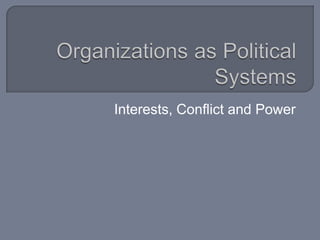
Organizations As Political Systems
- 1. Organizations as Political Systems Interests, Conflict and Power
- 2. Introduction I live in a democratic society. Why should I have to obey the orders of my boss eight hours a day? He acts like a bloody dictator, ordering us around and telling us what we should be thinking and doing. What right does he have to act in this way? The company pays our wages, but does this mean it has the right command all our beliefs and feelings? It certainly has no right to reduce us to robots who must obey every command!
- 4. Types of Political Systems Autocracy Power is held by individual or small group Bureaucracy Rule exercised through use of written word Technocracy Rule exercised through use of knowledge Codetermination Form of rule where opposing parties combine in the joint management of mutual interests Representative democracy Rule exercised through the election of officers mandated to act on behalf of the electorate Direct democracy The system where everyone has an equal right to rule and is involved in all decision making
- 6. Organizations as Systems of Political Activity An organization’s politics is most clearly manifest in the conflicts and power plays that sometimes occupy centre stage, and in the countless interpersonal intrigues that provide diversions in the flow of organizational activity. More fundamentally, however, politics occurs on an ongoing basis, often in a way that is invisible to all but those directly involved.
- 7. Organizations as Systems of Political Activity Relationships to be considered: Interests Conflict Power
- 8. Interests Three different types Task Interests Connected with the work one has to perform Career Interests Independent of the job being performed Extramural Interests Act towards the relation to both job and career
- 9. Conflict Where interests collide Conflict may be Personal Inter- personal Between Rival Groups Coalitions Built into Organizations Roles Attitudes Stereotypes Scarcity of resouces
- 10. Power
- 11. Power Power is the medium through which conflicts of interest are ultimately resolved. Important sources of power Formal Authority Control of Scarce Resources Use of organizational structure, rules and regulations Control of decision powers Control of knowledge and information Control of boundaries Control of technology
- 12. The Ambiguity of Power Interpersonal behavioural phenomenon VS Deep-seated structural factors
- 13. Ambiguity of Power Relationship between management and workers Unitary In Unitarianism, the organization is perceived as an integrated and harmonious whole with the ideal of "one happy family", where management and other members of the staff all share a common purpose, emphasizing mutual cooperation. Furthermore, unitary has a paternalistic approach where it demands loyalty of all employees, being predominantly managerial in its emphasis and application.
- 14. Ambiguity of Power Pluralist In pluralism the organization is perceived as being made up of powerful and divergent sub-groups, each with its own legitimate loyalties and with their own set of objectives and leaders. In particular, the two predominant sub-groups in the pluralistic perspective are the management and trade unions.
- 15. Ambiguity of Power Marxist or Radical This view of industrial relations looks at the nature of the capitalist society, where there is a fundamental division of interest between capital and labour, and sees workplace relations against this history. This perspective sees inequalities of power and economic wealth as having their roots in the nature of the capitalist economic system. Conflict is therefore seen as inevitable and trade unions are a natural response of workers to their exploitation by capital. Whilst there may be periods of acquiescence, the Marxist view would be that institutions of joint regulation would enhance rather than limit management's position as they presume the continuation of capitalism rather than challenge it.
- 16. Pluralist of five conflict handling modes Competing Collaborating Assertive Attempting to satisfy one’s own concerns Compromising Avoiding Accommodating Unassertive Cooperative Uncooperative Attempting to satisfy others’ concerns
- 17. Strengths and Limitations Taboo subject Pushing of private motives This metaphor overcomes the previous metaphors by placing a knowledge of the role and use of power at the centre of organizational analysis. Helps explain the myth of organizational rationality. Helps overcome the limitations of the idea that organizations are functionally integrated systems. Helps us understand human behaviour in organizations Encourages us to recognize the socio-political implications of different kinds of organization and the roles that organizations play in society
- 18. Strengths and Limitations Can lead to increased politicization of the organization Assumptions of Pluralism? MOVIE